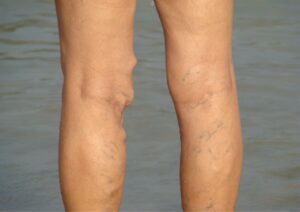Seroma, a common post-surgical occurrence, manifests as a collection of fluid in a cavity or pocket at the surgical site. This fluid buildup, though generally non-threatening, can lead to discomfort, delayed healing, and sometimes infection. Addressing seromas often involves various treatments, and among them, sclerotherapy emerges as a promising option. Sclerotherapy, a minimally invasive procedure breast cancer surgery that involves injecting a specially formulated solution into the seroma sac. This solution causes the walls of the sac to irritate and seal off, preventing further fluid accumulation. With skillful administration, sclerotherapy can significantly reduce seroma size and alleviate associated symptoms.Let’s delve into the world of seromas and explore how sclerotherapy offers a ray of hope in their management.
What is a Seroma?
A seroma develops as a result of surgery when lymphatic fluid or blood accumulates in the skin or surgical area, forming a fluid-filled cavity. While they can occur after various surgeries, they are more commonly associated with procedures like mastectomies, abdominoplasties, and hernia repairs.
Causes and risk factors of seroma
Seromas can be caused by various factors, including surgical procedures, trauma, infections, or even radiation therapy. During surgery, the disruption of tissue layers can create a space where fluid can accumulate. Additionally breast surgery, factors such as poor wound healing, excessive tissue trauma, and inadequate drainage can contribute to the formation of seromas.
Certain risk factors can increase the likelihood of developing seroma. These include obesity, older age, smoking, diabetes, and the presence of pre-existing medical conditions such as breast cancer. Understanding these risk factors can help healthcare professionals identify individuals who are more susceptible to seroma formation and take preventive measures.
Symptoms and complications of seroma
Seromas can present with various symptoms, depending on their size and location. Common symptoms of seroma may include swelling, pain, tenderness, and a feeling of fullness or heaviness in the affected area. In some cases, seromas may cause limited mobility or restrict movement due to the discomfort they cause.
While seromas are generally not life-threatening, they can lead to complications if left untreated. Infection is a potential complication most seromas, as seromas provide a favorable environment for bacteria to grow. In severe cases, large seromas can put pressure on surrounding tissues, leading to tissue necrosis or impaired wound healing.
The science behind seroma formation
Understanding the underlying mechanisms of seroma formation is crucial for effective treatment. Seromas occur due to a disruption in the normal healing process. When tissue layers are separated, a space is created where fluid can accumulate. This fluid is primarily composed of serum, a clear, yellowish fluid that contains various proteins and cells involved in the healing process.
The accumulation of serum occurs due to an imbalance between the production and absorption of fluid within this space. In normal wound healing, the body’s lymphatic system helps remove excess fluid and waste products. However, in the case of seroma formation, the lymphatic system may be overwhelmed or compromised, leading to fluid accumulation.
Understanding Sclerotherapy:
Sclerotherapy, primarily known for treating varicose veins, involves the injection of a sclerosing agent directly into the seroma cavity. This agent initiates a controlled inflammatory response, causing irritation and subsequent closure of the cavity. The surgical procedure also aims to encourage the body to absorb the fluid and stimulate tissue adherence to prevent further accumulation.
The Role of Sclerosing Agents:
Different sclerosing agents like saline, ethanol, or detergents are utilized in sclerotherapy. These substances trigger inflammation and encourage the formation of scar tissue, effectively sealing off the cavity and promoting the absorption of the seroma fluid.
Benefits of Sclerotherapy in Seroma Treatment:
1. Minimally Invasive: Sclerotherapy is minimally invasive, performed as an outpatient procedure in many cases treat breast cancer, reducing the need for extensive surgery.
2. Targeted Approach: The injection is precisely administered into the seroma, directly addressing the serous fluid buildup.
3. Reduced Recurrence: By promoting adhesion and absorption, sclerotherapy minimizes the likelihood of seroma recurrence.
4. Improved Healing: Closure of the seroma cavity aids in faster healing and reduced discomfort for the patient.
The Procedure in Practice:
During sclerotherapy, a physician typically uses ultrasound guidance to accurately locate the seroma cavity. A fine needle is then inserted into the cavity, and the sclerosing agent is slowly injected. Multiple sessions might be required depending on the size and persistence risk of infection of the seroma.
Potential Risks and Considerations:
While generally safe, sclerotherapy may carry risks such as infection, irritation at the injection site, or allergic reactions to the sclerosing agent. It’s crucial to discuss these aspects with your doctor or a healthcare provider before opting for the procedure.
Alternative treatments for seroma
While sclerotherapy is an effective treatment option for seroma, alternative treatments may be considered based on the specific circumstances. Seroma drainage is a commonly used method in which a healthcare professional uses a needle or catheter to remove and drain the accumulated fluid. This procedure may be performed as a standalone treatment or in combination with sclerotherapy.
In some cases, surgical intervention may be necessary to remove the fluid collection the seroma completely. Surgical drainage involves making an incision to access the seroma sac and remove the fluid. This approach is usually reserved for larger or persistent seromas that do not respond to less invasive treatments.
Preventing seroma recurrence
Preventing seroma recurrence is an important aspect of medical treatment of seroma management. Healthcare professionals may recommend certain preventive measures based on the individual’s circumstances and risk factors. These measures may include the use of compression garments, the application of negative pressure wound therapy, or the administration of medications that promote lymphatic drainage.
Additionally, proper wound care and hygiene are crucial to prevent infection and promote healing. Following the healthcare professional’s instructions on post-procedure care and attending regular follow-up appointments are essential for monitoring the progress and addressing any concerns.
Conclusion:
Seromas, though common post-surgical occurrences, can impede recovery and cause discomfort. Sclerotherapy presents a promising avenue in managing seromas by directly addressing the fluid accumulation. As medical advancements continue, sclerotherapy stands out as a minimally invasive and effective approach to mitigate the impact of seromas, offering patients a smoother recovery and enhanced healing following surgery. Consulting with a healthcare professional remains essential to determine the most suitable treatment plan for individual cases of seroma and sclerotherapy.









